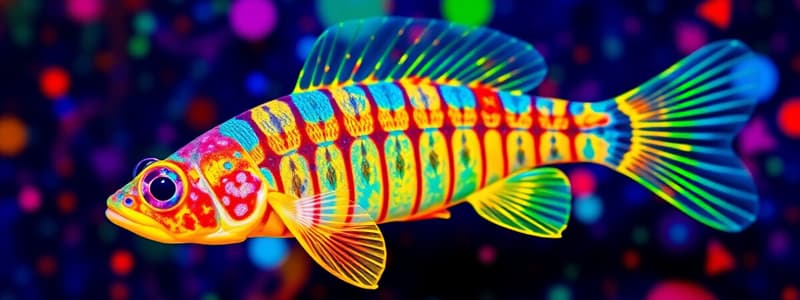Podcast
Questions and Answers
What is the role of fovea-like photoreceptor specializations in zebrafish vision?
What is the role of fovea-like photoreceptor specializations in zebrafish vision?
- They allow for selective tuning to specific prey types. (correct)
- They enhance the detection of light in dim environments.
- They enable the recognition of color patterns in prey.
- They improve peripheral vision in low light conditions.
What would likely happen to the prey detection ability of zebrafish if UV cones are ablated?
What would likely happen to the prey detection ability of zebrafish if UV cones are ablated?
- Prey detection would be enhanced due to reduced noise.
- Prey detection would become less efficient, impacting feeding behavior. (correct)
- Prey could be identified using only peripheral vision.
- Prey detection would not be affected significantly.
What fundamental property of vision do photoreceptor tuning and functional specialization represent?
What fundamental property of vision do photoreceptor tuning and functional specialization represent?
- Increased overall visual acuity across all retinal regions.
- Limiting visual information based on neural processing speed.
- Enhancing color perception in all conditions.
- Adaptation to various sensory tasks based on retinal location. (correct)
Which visual mechanism do larval zebrafish utilize to capture prey?
Which visual mechanism do larval zebrafish utilize to capture prey?
What does the longer integration time of foveal cones suggest about their function?
What does the longer integration time of foveal cones suggest about their function?
How do internal models influence dragonfly interception steering?
How do internal models influence dragonfly interception steering?
What is the significance of the winter reversal in response modulation for prey capture?
What is the significance of the winter reversal in response modulation for prey capture?
What role do inhibitory synapses play in behavioral response filtering?
What role do inhibitory synapses play in behavioral response filtering?
Which type of photoreceptor is specialized for low-light vision in the vertebrate retina?
Which type of photoreceptor is specialized for low-light vision in the vertebrate retina?
In zebrafish, what is the primary driver of their prey-capture behavior as identified in research?
In zebrafish, what is the primary driver of their prey-capture behavior as identified in research?
What distinguishes cone photoreceptors from rod photoreceptors?
What distinguishes cone photoreceptors from rod photoreceptors?
Which behavioral response is observed with a bright on a dark background?
Which behavioral response is observed with a bright on a dark background?
What general trend was noted regarding prey-catching behavior in winter for dragonflies?
What general trend was noted regarding prey-catching behavior in winter for dragonflies?
What is the primary purpose of the UV cone's outer segment size variation?
What is the primary purpose of the UV cone's outer segment size variation?
What is indicated by the light bias and high gain of SZ UV cones?
What is indicated by the light bias and high gain of SZ UV cones?
What role do inhibitory synapses play in the context of UV cones in zebrafish?
What role do inhibitory synapses play in the context of UV cones in zebrafish?
Which feature of UV cones may signal the presence of prey?
Which feature of UV cones may signal the presence of prey?
What processing technique is used to maximize signal-to-noise ratio (SNR) in ROI detection for UV cones?
What processing technique is used to maximize signal-to-noise ratio (SNR) in ROI detection for UV cones?
What specific size criteria were applied during the ROI filtering process?
What specific size criteria were applied during the ROI filtering process?
How does the structure of UV cones contribute to their role in vision?
How does the structure of UV cones contribute to their role in vision?
What psychophysical aspect is important in the behavioral response of zebrafish to UV cones?
What psychophysical aspect is important in the behavioral response of zebrafish to UV cones?
Study Notes
Introduction
- Photoreceptor tuning is essential for efficient visual sampling across the retina.
- Photoreceptor tuning is a fundamental property of vision in both invertebrates and vertebrates.
- The focus is on UV cones in larval zebrafish and their role in prey capture behavior in the "strike zone."
- Larval zebrafish use UV vision to detect prey.
Prey Capture Behavior in Zebrafish
- Larval zebrafish prey capture behavior is dependent on UV vision.
- Zebrafish orient towards prey when UV cones are stimulated.
- Ablation of UV cones results in a loss of prey capture behavior.
Photoreceptor Specialization: UV Cones in Zebrafish
- The size of UV cone outer segments varies dramatically across the eye.
- Larger outer segments are found in the "strike zone" where UV sensitivity is needed most.
UV Cone Function in the "Strike Zone"
- UV cones in the "strike zone" have specialized properties.
- UV cones in the "strike zone" are "light biased" - they respond more strongly to bright stimuli on a dark background.
- UV cones in the "strike zone" have a high gain and long integration times.
Experimental Methods
- Calcium imaging using syGCaMP6f, a synaptically tagged fluorescent calcium biosensor, was used to measure UV cone activity.
- Regions of interest (ROIs) corresponding to individual presynaptic terminals of UV cones were defined automatically based on local thresholding.
- ROIs were filtered for size and shape, ensuring analysis of round ROIs of specific size ranges.
Studying That Suits You
Use AI to generate personalized quizzes and flashcards to suit your learning preferences.
Related Documents
Description
This quiz explores the relationship between photoreceptor tuning, specifically UV cones, and the prey capture behavior of larval zebrafish. It delves into how these specialized photoreceptors function in the 'strike zone' for efficient prey detection. Understanding the importance of UV vision in both invertebrates and vertebrates is key to grasping their feeding mechanisms.




